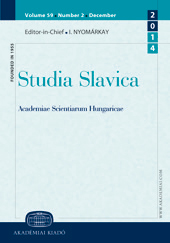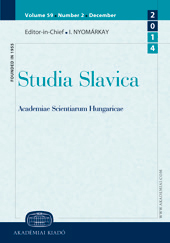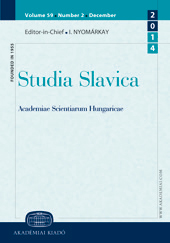
We kindly inform you that, as long as the subject affiliation of our 300.000+ articles is in progress, you might get unsufficient or no results on your third level or second level search. In this case, please broaden your search criteria.


The paper presents the results of a comprehensive study on Anna Dostoevskaja’s role in the creative process of Fyodor Dostoevsky. She was not only the wife of the great writer but a professional shorthand writer and a copyist as well. At the time of writing his novel The Gambler, Dostoevsky and his assistant worked out a model of creativity in which priority was given to stenographic writing that could trace and fix the writer’s exciting ideas. During the subsequent work on his literary writings including e.g. The Great Pentateuch, this model of the creative process remained unaltered. Dostoevsky’s wife was his Muse, co-thinker, interlocutor, the first listener and the first critic of his creations, and the co-author of burlesque verses. Her impressions, stories, and their private conversations were used by Dostoevsky in his literary works. Several years of joint creative work with the brilliant writer developed in his assistant literary skills thanks to which she wrote masterful memoirs that obtained worldwide recognition. Dostoevsky appreciated his wife’s contribution to his literary activity thereby dedicating his greatest novel The Brothers Karamazov to her.
More...
Gogol’s art (first of all, his works Dead Souls and Selected Passages from the Correspondence with the Friends) is considered in the aspect of the problem of a “philosophy of an economy” formulated by S. Bulgakov. Gogol’s views also are correlated with its development in the art of I. Goncharov (Oblomov) and L. Tolstoy (first of all, his late works)
More...
Dostoevsky was familiar with the oeuvre of Blaise Pascal. It is provable that he read the book Pensées. One of the central concepts of this book (“les extrémités se touchent”) is cited in the novel The Idiot. In my essay, I make an attempt to reconstruct the original context of the citation. I sketch two possible interpretative practices of the cited anthropological concept: the cognitive and the heuristic one (“le coeur a son ordre, l’esprit a le sien”). There is a special type of text which corresponds to each of them. In The Idiot, the cognitive strategy is risen up to an ideological level by the statements of the main character, meanwhile the heuristic text production is realized by the narrative metaphors of the confession discourse. In my essay, I put a special emphasis on the problem of fragment and its functioning in the structure of prose language
More...
From the point of view of historical poetics, the genre model of Gogol’s Dead Souls can be connected to variations of a picaresque novel (Aleman, Grimmelshausen, Sorel, Lesage, Narezhny, etc.). The author demonstrates the proximity of Dead Souls to picaresque novels presuming the possibility of change and transformation of the protagonist.
More...
This article demonstrates that the myth of Oedipus mentioned directly in the novel underlies A Common Story by Ivan Goncharov. In the extensive system of references to the myth exposed by us, Petr Aduev is brought into correlation with Oedipus in the fact that he, like Oedipus, involuntarily ruins his relatives. Under the influence of his uncle Alexander, Aduev ends up with the spiritual death, and the novel also contains a symbolic motif of incest. As a result of the husband’s inability to give the salvational love to his wife she becomes – as the novel says – “inanimate”. Elisabeth is also threatened with the actual death, though the illness itself has not commenced as of yet. A Common Story is a mythological novel, in which an ancient myth manifests itself in the reality contemporary to Goncharov.
More...
The aim of the present paper is to reveal the allegorical and metaphorical plan of L. Tolstoy’s short story The Death of Ivan Ilyich through the problems of human and family relationships. The main aspects are rounded off by analysing the connected details.
More...
“Every Russian writer owes something to Gogol.” This Nabokovian statement questions beliefs traditionally formulated in respect to Gogol’s oeuvre. His book paradoxically introduced by the depiction of the writer’s death implies that the motif of death has a specific impact on the genesis of the artefact. The similar postmodernist theory by Terc echoes in part ideas found in the symbolist perception of Gogol (Annensky, Blok, Rozanov, Merezhkovsky, and Andrei Bely). Gogol’s poetics centered upon this principle, reminiscent of Dante’s Divine Comedy, can be traced throughout the works of Russian authors – a thesis to be scrutinised in a series of forthcoming articles. The irrational in Gogol’s views concerning true art thus shall discard the labels of critical realism and art envisaged as the device meant to perfect human society, consequently via the transmutation of the self shall true art fulfil its ultimate mission. Introducing the dichotomy of ‘poet’ – ‘non-poet’ indicates a precursor of the Solovyovian doctrine of the superman. The ideal of transgression is expressed through applying the medieval interpretation of the language distinguishing Dante’s work, offering a profound reading of texts. The poetics of death penetrating Gogol’s works implicates handling and interpreting of various phenomena of culture synthesised, including models of self-perfection realised by alchemy, freemasonry, and Russian sophiology.
More...
Creative memory is the dominant feature in the writing process of Nabokov’s prose in general, and that of the novel The Gift in particular. Mnemosyna in Nabokov’s word has many faces, such as memory concrete, creative recollection, mystic-transcendental as well as cultural-reminiscential memory. The concrete memory of an event produces the illusion of lifelikeness; the rest of Mnemosyna’s hypostases weave a magic fabric of artistic endeavor. It can be observed in the specific style of Nabokov’s prose: loyalty to reality of life blended organically with fantasy and irrational-transcendental epiphanies of the artist-demiurge.
More...
While Tolstoy’s ideological and religious turn is often mentioned in the special literature, the turn in his poetics is hardly ever. The present study focuses on the latter phenomenon. After the turn in his ideology and poetics, Tolstoy searched for such new forms to express his moral and philosophical thoughts as the legend, the apologue, the parable, the hagiography and the confession, etc. He elaborated such a comprehensive form of the short story which approaches the novelette in its length but condenses the conflict in a dramatic manner at the same time. The works to be analyzed here are the following: What Men Live By?, How Much Land Does a Man Need?, Father Sergey, Master and Man, Posthumous Papers of the Elder Fedor Kuzmich, The False Coupon. It is possible to understand the deeper meaning of these parables only if one is able to discover the archetypal mythemes in the deep structure of the concrete text, and trace them back to their primal form, which universalizes the mystery of resurrection for the receiver. The conclusion of this paper is that Tolstoy considered self improvement a universal law, with the help of which man can learn truth and transform it into living practice: aletheia turns into ethos
More...
The heroine of L. Ulitskaya’s Sonechka is reading a play by Schiller. The work, which seems to be entirely unmotivated on the level of the plot, proves to be an exceptionally important code with regard to the poetics and esthetics of Ulitskaya’s short story. This paper examines how the Russian author revives Schiller’s game theory and how the short story itself can be interpreted on the basis of esthetic game theories.
More...
In the first place, the paper ventures to trace what the Blok phenomenon meant for Pasternak and it tries to interpret the definition in the novel “Doctor Zhivago” which says that Blok was the manifestation of Christmas himself. Thereunto it examines the role of the topic and motives of Christmas in Blok’s poetry and publicity. In the greater part of the writing, it traces down the (thematical, motional, metrical, and rhyme) intertextualities that can be discovered between the cycle “The Poems of Doctor Zhivago” and Blok’s poetry, and also their dynamics within the cycle. The poem “Fairy Tale” and the “Mary Magdalene” cycle proved to be of major importance.
More...
One of the dominant streams of contemporary Russian literature is often called dirty realism or cruel literature as it is rather fond of portraying pathological personalities, representing brutal cruelties, sadistic and masochistic as well as necrophilic scenes. Sensuality returns to literature by the deformation, degradation and dissolution of the body. The physical processes provoking disgust are described in an obscene, rude language, thus border crossing and taboo demolishing take place on the stylistic level, too. Based on the works of Victor Yerofeev and Vladimir Sorokin, my paper examines the philosophic and anthropologic roots of this aesthetic, intellectual and ethical provocation.
More...
Many post-modern texts are inspired by the sub-genre of the picaresque novel. To refer to Gérard Genette’s category, it renews and reinvigorates tradition through imitation and indirect transformation. In texts dating from the second half of the 20th century, the picaresque novel mainly serves as a formal framework of playing with literariness. As post-modern space evokes the notion of emptiness or unfinished state (Mikhail Epstein), so does the journey itself become a shrivelling conceptual framework externally (when the emphasis is placed on natural, physical environment revealed in the wake of the journey) as well as internally (when the traveller turns inwards). It is exactly through reporting on the “ruined-state status” and taking an extensive journey in linguistic space that this framework can be “filled up.” Placing the emphasis on the text-oriented nature of Venichka’s character, this study will view her mainly from the perspective of the allegorical journey of Dostoevsky’s Prince Myshkin.
More...
Doctor Zhivago begins with such motifs as funeral (of Yura’s mother Maria Nikolaevna), four shovels, an unuttered word on grave, a snowy storm, a monastery garden with moiré rows of cabbage, a low-closed window and a desire to rescue that cabbage. And it ends with motifs of an enigmatic wide-open window (somewhere above the Moscow) and the reading of Yurij Zhivago’s writings. My main question is how these motifs are connected. Particularly, what happened to the cabbage and where Yurij’s writing pad came from. The Russian «тетрадь Юрьевых писаний» („notebook of Yurij’s writings”) contains the meaning ‘four’ (from Greek τέτραδιον, τέτρα), which together with the word «писание» („writing”) leads to «Четвероевангелие» (Holy Writing, Holy Scripture, Four Books of the Gospels). During the second funeral (of Anna Ivanovna) at the same graveyard instead of cabbage Yura sees washed clothes and thinks about his future writings, which he names as «Откровение Иоанна» („The Revelation to John”). According to Dahl, Russian folk-puzzlers about cabbage contain such answers as “year”, “cloth”, and “book”. In addition, Yura’s family name after his mother is Vedenyapin, derived from Benedictus (‘good’, bless speaking’), and the name of his brother Evgraph means ‘good, bless writing’. Shortly speaking, Yura himself is some kind of a ‘word’. Here’s why the novel begins with a deep unuttered word of little Yura and ends with a writing pad (prepared by Evgraph) of Yurij’s writings. All such observations are not evident on the plot level. Pasternak’s novel has a paradigmatical structure like the theme with variations. Every next step (chapter) plays the role of semantics of the previous one and leads to transformation. Nevertheless, without the plot’s metamorphosis.
More...
My paper aims at examining the poetics of Sergei Dovlatov’s novel Sanctuary, with particular emphasis on motivic repetitions and the Pushkinian intertexts embedded in the novel. It reveals a complex relationship linking Dovlatov the author, Alikhanov the narrator, Alikhanov the protagonist and the narrative itself to Pushkin’s life, persona, his texts and language. By referring to two Pushkinian intertexts, I argue that Alikhanov’s understanding of Pushkin develops simultaneously as his relationship to his wife Tanya progressively becomes a text. Alikhanov recreates Pushkin’s ars poetica for himself by aphoristically identifying the poet with an indifferent nature. The fictional equivalent of this will be Tanya, whom Alikhanov the narrator describes with the attributes of indifference. This motif of indifferent nature establishes a connection between Pushkin’s lyrics and Dovlatov’s text. Pushkin, the greatest cultural subject in Russia’s collective memory, is salvaged by Dovlatov’s text through Alikhanov’s Tanya as well as the narrator’s own personal history; a history that necessarily evolves from Pushkin. Alikhanov the protagonist and Alikhanov the narrator interpret Pushkin in the context of their own crucial, existential questions, the questions of amorality and destiny, and the possibilities of late modern-postmodern prose writing.
More...
Andrei Bely’s Kotik Letaev was written in 1915, and it is about the functioning of the creative mind, the genesis of consciousness, and the mechanism of its functioning. In the novel revised several times, the writer shows the obvious influence of the anthroposophic interpretation of Rudolf Steiner. According to the novel, consciousness is not a pre-set, closed world, and the forms of reality and the new stages of the functioning of consciousness demonstrate a close correlation, where the levels of consciousness are interpreting themselves. The subjects of narration are the events happening inside the consciousness. Self-consciousness comes to know and analyze itself, and it builds itself up, making the effects of the world immanent. The main character of the autobiographic novel is a 35-year-old man, and we can see the changes of a child’s consciousness in a retrospective way through his point of view. These changes are similar to the swings of a pendulum in time and space, like the geometrical form of a spiral, and at the end of the novel the hero’s consciousness is complete and consistent. The character of the spiral is an important principle of the novel’s organization, it maps the levels of developing consciousness and the functioning of memory. It is also the symbol of growing consciousness in the life of Kotik who can increasingly perceive his environment.
More...
In A. Belyj’s creativity has repeated historical stages of visualization of prose: from solidity to step-type behaviour. A. Belyj accumulated all previous experience, absolutized use of visually-graphic receptions and through a discrete space of page has expressed step-type behavior of consciousness of the whole epoch, ingeniously having foreseen the occurrence of a new visual thinking.
More...
The author analyzes the narrative structure of Aleksandr Solženicyn’s novel V kruge pervom. She examines inner monologues and dialogues and finds both homophonic and polyphonic features in them. She proposes to label this special case as heterophonic, which is meant to be a kind of alloy of homophony and polyphony and whose function is probably to underline the need for dialogues in a society subdued to one idea and one voice.
More...
The author analyzes the motif of the cross in Aleksandr Solženicyn’s novel V kruge pervom and indicates the major aspects of the motif. She discusses the specific of these aspects and establishes the role of the motif with regard to the main characters of the novel (Nadja, Nerzhin and Innokentij). She also indicates the importance of the expression “to hit the four nails of memory” related to the motif of the cross.
More...